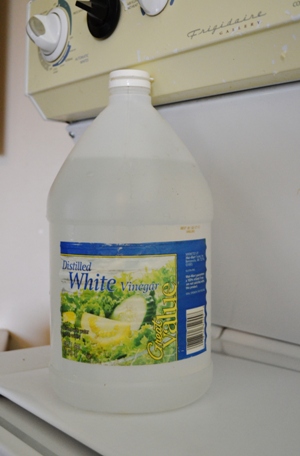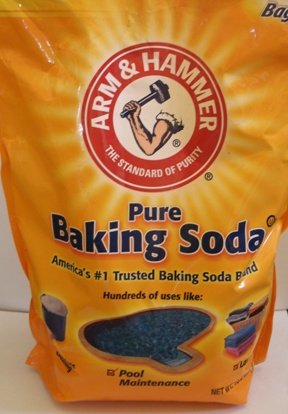Bigger Results From Your Money and Time
Bigger Results From Your Money and Time - Money saving tips and ideas
Making Homemade Fabric Softener with Baking Soda or Vinegar
- Does it Really Save Money?

Using baking soda can leave a white powder reside on clothing if it is not dissolved in water before adding to the rinse water, but it does work nicely as a fabric softener.
Vinegar has a sharp odor that quickly goes away when the clothes are dry, but it also works well as a fabric softener.
Commercial fabric softener, especially my favorites Downy and Snuggle, also do a fine job of softening clothes and they also leave a pleasant scent in the clothing after they are dry. That is, unless you use too much fabric softener, then it leaves a smell of overpowering chemical perfumes that can take days to air out.
I use baking soda or vinegar instead of commercial fabric softener for a variety of reasons: If I have run out of fabric softener, or I'm tired of the perfumy scent of the fabric softener. Sometimes I want to use baking soda because it can help get the clothes a little cleaner during the rinse cycle. I also go through long periods of time when I want to eliminate extra chemicals that fabric softeners leave on the clothing I wear and in the groundwater after the rinse water drains from the washer.
Whenever I use baking soda or vinegar instead of fabric softener, I always feel a bit of satisfaction that I am saving a bit of money as well as eliminating chemicals. But the other day, it hit me. Am I really saving money? Is it really cheaper to use baking soda or vinegar instead of fabric softener?
I decided to do the math and find out.
FABRIC SOFTENER COST
First let's look at the cost per load of fabric softener.
Sams' Club** has several choices
| Brand | Cost | Size | # Loads | Cost/load |
| Ultra Fresh Downy | $11.98 | 170 oz | 197 | 0.060812 |
| Final Touch Ultra | 4.88 | 120 oz | 60 | 0.081333 |
| Members Mark Liquid Fabric Softener | 8.48 | 168 oz | 195 | 0.043487 |
Consumersearch.com rates Gain Ultra Liquid Fabric Softener as the best liquid fabric softener, so let's price that, too.
| Gain Ultra | 7.97* | 103 oz | 120 | 0.066417 |
*Gain Ultra price is from walmart.com and does not include shipping costs.
The cost of liquid fabric softener ranges from $.04 per load (Members Mark brand) to $.08 per load Final Touch Ultra).
VINEGAR COST PER LOAD

Sam's Club has packs of 2 gallons of vinegar for $3.58. This is a total of 32 cups of vinegar.
A cost of $3.58 for 32 cups is a cost of $0.111875 per cup , rounded to $0.11 per cup of vinegar.
Martha Stewart recommends 1/4 cup to 1 cup of white vinegar in the final rinse cycle. This would make the cost of using vinegar as fabric softener range from $.03 per load to $.11 per load.
Mother Earth News recommends 1/2 cup of vinegar per rinse cycle. This would make the cost $.06 per load.
I typically use 1/2 cup of vinegar in the final rinse cycle, so my cost would be $0.06 per load.
If I used 1 cup, the cost would increase to $.11 per load.
Yes, $.06 times 2 should be $.12 - a penny got lost in the rounding. It'll show up one day in the bottom of the washing machine tub.
BAKING SODA COST PER LOAD
 Finally, let's see how much it costs per rinse load to use baking soda as fabric softener.
Finally, let's see how much it costs per rinse load to use baking soda as fabric softener.
Sam's Club sells 13.5 lb bags of baking soda for $6.87.
Yes, I realize that is a LOT of baking soda. I buy it anyway. I use it.
There are .486 tablespoons of baking soda per ounce. That makes 444.444 tablespoons in a 13.5 lb bag.
At $6.87 a bag, that makes the cost per tablespoon equal $0.015458.
Walgreens sells baking soda in orange 1 lb boxes.
| Size | Cost | Tbs/bag | Cost/Tbsp | |
| Sam's Club | 13.5 lb | $6.87 | 444.444 | $0.015458 |
| Walgreens* | 16 oz | $1.00 | 32.92181 | $0.030375 |
*Walgreens.com
To use baking soda as a fabric softener in the rinse cycle, add 1/4 to 1/2 cup of baking soda to the water. (If you add more than this, you will likely end up with clothes covered with white powder at the end of the cycle. Baking soda does not easily stay dissolved in water. Take a look at my experiment Making Washing Soda From Baking Soda to have an idea about how baking soda dissolves in water.
When I use baking soda, I use 1/2 cup. I've tried to make myself use 1/4 cup, but I always end up scooping out a little more because it just doesn't seem like enough.
1/2 cup = 8 Tablespoons. 1 tablespoon of baking soda costs $0.015 to $0.03, depending on whether you buy a small orange box or a big orange bag of the stuff.
Therefore using 1/2 cup baking soda as fabric softener in the rinse cycle will cost $.12 (Sam's Club baking soda) to $.24 (Wagreens) per load.
Summary Comparison of Costs - Baking Soda, Vinegar, and Fabric Softener
So. Let's compare our results.
Fabric Softener - Cost is $.04 to $.08 per load
Vinegar - Cost is $.06 to $.11 per load
Baking Soda - Cost is $.12 to $.24 per load
Not the Results I Was Hoping For
With the exception perhaps of the cheapest vinegar compared to the most expensive fabric softener, you are not saving money by using vinegar or baking soda instead of commercial fabric softener. In fact, you could be paying up to three times as much per load.
When I use fabric softener, I usually use only 1/2 the recommended amount. I have a dryer ball - it looks like a rubber ball with rounded spikes - that helps to fluff the clothes but makes static cling much worse when used alone. A small amount of fabric softener in the rinse cycle eliminates the static cling in the dryer. So, for me, the cost of using vinegar or baking soda could be 3 or 4 times as expensive as commercial fabric softener.
You Can Really Waste Your Money by Mixing Baking Soda and Vinegar in the Rinse Cycle
You probably have seen a recipe or two for fabric softener or even a cleaner that mixes baking soda and vinegar. This is a waste of money. Baking soda has a pH of 8.4 (alkaline). Vinegar has a pH of 2.4 to 3.4 (acid), depending on the concentration of the acetic acid, which normally varies from 5-10% for most vinegar that you will purchase in the store.
When you mix the two, you create a chemical reaction that creates Sodium Acetate (NaC2H3O2), which is a salt, and H2CO3, which is CO2 and water (Carbonic Acid, similar to a carbonate beverage). The H2CO3 effect will be quickly lost in the water and you will be left with mostly salt - Sodium Acetate.
Mixing alkaline and acid creates an effect to neutralize one or the other or both, depending on the pH and the quantities added together. So, depending on whether you add more vinegar or more baking soda, you will neutralize the pH of one or both of them. Losing the pH effect also reduces or eliminates the ability of the mixture to change the pH of your rinse water, which is what why you are adding the vinegar or baking soda in the first place. The only redemption would be if the resulting chemicals, Sodium Acetate or Carbonic Acid, would be beneficial for cleaning or softening.
Sodium Acetate has some uses, such as for flavoring in the food industry, but the only use I can think of for cleaning would be the gritty texture. Not exactly what you desire for your rinse load.
There are some occasions where it is beneficial to mix baking soda and vinegar for cleaning. In these cases, the cleaning power comes at the point of the chemical reaction between the baking soda and vinegar. The reaction itself - and the resulting bubbles and foam (Carbonic Acid and water) - creates the cleaning effect. This is good when you are clearing a clogged drain or cleaning a stain from a carpet. The effect makes little difference and is gone quickly in the washing machine.
Why I Still Use Vinegar and Baking Soda for Laundry Purposes
Now that we've determined that there are no money savings by substituting vinegar OR baking soda in the rinse cycle, why would we still want to consider using one of them?
Good question.
First of all, the obvious: fabric softener has a laundry list (pun intended) of chemicals, many of which can cause skin irritations, allergic reactions, or worse. For good reading on this, refer to the article by NaturalNews.com Fabric Softeners Contain Toxic Chemicals.
Second, many fabric softeners contain perfumes that can be downright annoying if you don't like the scent.
Third, and possibly one you were not aware of, so moms may want to pay attention: Fabric softeners can create a build up on clothing that becomes highly flammable. This is especially true if you regularly use too much fabric softener. So, if you do continue to use fabric softener, please remember, for the sake of your kids, to always use a little less than recommended, or skip it all together for your kid's nightclothes. Refer to KOMOnews.com which found in their experiments that nightgowns treated with liquid fabric softener ignite immediately and burn faster.
As an afterthought, if you have elderly family members who might not be quite alert around their stoves or any open flames, be very sure that their bathrobes and other loose clothing do not get any build up of fabric softener.
You can reduce or eliminate fabric softener build up on clothing by doing periodic rinse cycles with 1/2 to 1 cup of vinegar. Keep reading.
And finally, fabric softeners can actually reduce the absorbency and softness of clothing, especially bath towels.
Why use baking soda?
Baking soda is good if you have very hard water. The baking soda, with it's pH of 8.4, will not only help to neutralize and soften the water (and therefore your clothing), but it also acts a mild cleaning agent so your clothes get a second, mild wash in the rinse cycle.
Just remember not to use too much (1/2 cup is the most I'd recommend) or you will have white powder streaks on your clothing. Baking soda, because it does not dissolve all that well in water, is also a bad choice if you have a packed load of clothing in the washer. The baking soda will find it's way into all the folds of the clothing and basically stay there because over-full loads in the washer do not allow the clothing in the tub to move about freely.
If that happens, and you discover clothing with white power as you pull it from the dryer, you can usually easily rinse the white streaks out and dry the clothing again.
Why use Vinegar?
Vinegar has several benefits in the rinse cycle. It can soften water by helping to dissolve mineral particles. It helps to brighten whites, brighten colors, and eliminate odors. It also reduces static cling. It can even act as a anti-bacterial rinse.
Possibly the best benefit of using vinegar is the ability of vinegar to reduce or remove soap and fabric softener build up. This is especially true if you are using a soap-based laundry product, as the homemade laundry liquids or powders often are. Vinegar will help to remove soap reside from your clothing, leaving them soft and fresh.
The vinegar odor quickly dissipates and leaves clothes with a rain-washed, very fresh scent. I'd call it "pure clean air scent" if a vinegar bottling company ever called me and asked me what they should call the resulting clothing fragrance of using vinegar in the rinse cycle.
No one has called me, though.
In addition to removing soap residue from your clothing, vinegar in the rinse wash will also help to remove soap and fabric softener residue from your washing machine and washing machine hoses. This in turn will extend the life of your washing machine and also help to reduce maintenance calls and possibly service repair calls on your machine.
This may make vinegar the less expensive choice after all. If we assume that vinegar costs about $.02 more per load than fabric softener, and also assume that you will do five loads of laundry every week, this means that you will spend an extra $.10 per week and therefore an extra $5.20 per year by choosing vinegar over fabric softener in the rinse cycle.
While putting vinegar directly on fabrics is usually harmless, I'd recommend diluting the vinegar before adding it to the rinse cycle, or adding the vinegar after the tub has filled with water. That way you don't risk creating a light spot on any clothing with delicate dyes.
If using vinegar saves just one clogged hose, one service call, or saves a few pieces of clothing from getting dingy and therefore discarded, then you will have more than recovered your $5.20 in a year.
The Final Spin
Vinegar seems to be the winner here. While it does cost a few pennies more per load, in the long run the benefits of vinegar in the rinse cycle will likely save you enough in clothing replacement and washing machine repair costs that it will more than recover the few extra cents per week.
Long term savings, clothing free of soap and fabric softener residue, whiter whites and brighter colors, reduced exposure to harmful chemicals, increased safety by reducing flammable buildups, and a cleaner, better maintained washer. Now that's The Fat Dollar way.
Article by Patti Tokar Canton © 2013 All Rights Reserved
The Fat Dollar Ideas
In the Kitchen - grocery shopping, cooking, planning ... get some Fat Dollar Ideas
Vitamins and Fruit Juice - save $63.87 a year and 20,440 calories
Recipes for Stale Marshmallows
How to Re-Crisp Stale Ready-to-Eat Cereal
Save Money on Food with Inexpensive Clothespins
Microwave Muffins - Worth the Energy Savings? - the experiment and the recipe
Save Grocery Money Books - free bonus cookbook with purchase
26 Good Uses for Used Coffee Grounds
In the Home - tips and ideas to save money in your home
Make Your Own Shampoo and Rinse - Herbal or Plain
Is Vinegar Cheaper to use than Fabric Softener?
Stay Cool in the Summer With These House Cooling Tips
Does it Save Money to Use Toilet Paper Instead of Facial Tissue?Rechargeable Batteries - Energetic Cost Savings
Washing Soda from Baking Soda Cost
The Washing Soda Experiment - Can You Make Washing Soda from Baking Soda?
My Failed pH Test: Making Washing Soda - The Unexpected Find
Another Washing Soda From Baking Soda Experiment (This Time the pH Test Works)
Save Money on Anti-Aging and Skin Care Creams
Stop Comparing and Just Enjoy Your Life
More Low Cost Gift Ideas for High Impact
Christmas Gift Ideas for $10 or Less
Manage Your Money - Tips for managing your Fat Dollars
How to Stop Impulsive Spending
Check on Your Income Tax Refund Status
Save Money on Gas - Increase Your Mileage Up to 26%
Find Your Car's Expected Miles Per Gallon to Save
Let Uncle Sam Help Finance Your Retirement Plan
Tips For Lowering Income Taxes
Bartering Online or Offline - To fatten up your dollars
Fat Dollar recommends Simply Free Stuff site - Free samples and products
Books to help you save money and regain control of your Fat Dollars
